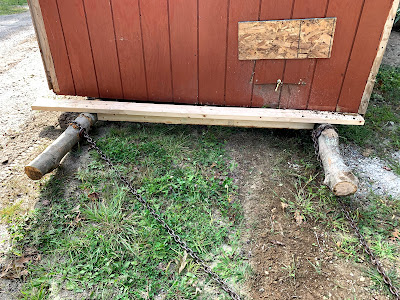The Adventure of Moving a Chicken Coop
You know when you look in a room and you know that it'll be better if the couch is over there, well that is how we are viewing the backyard. We have a nice big barn up and are changing the landscape enough, that it just seems natural to move the original chicken coop to a new spot on the farm side of the yard. In the photo above, you can see the coop is already prepped for the move. Two nice size trees were cut down where the pasture is going and they will be the sleigh poles for the big move.
First, we needed to move the girls to safety so that they weren't frightened during the big move. They had fun checking out the barn. We left them the ladder to keep them busy.
After the trees were cut and ready, Pepere Larry asked for a lot of bits of scrap wood and this is why. We used them to lever the building up one corner at a time and slide in a piece of wood at time to keep lifting it higher and higher until the trees could slide underneath one on each side. It sounds simple, but it was a lot of work and made a little more difficult, due to a stump under the coop.
Here are the poles, supported by two by fours to hold the poles in place under the coop. The chains are attached and the truck will pull this a little at a time to the new location.
One, two, three... pull!
The coop is off the stump and moving in the right direction.
We're making great progress moving this coop across the lawn, but the ditch is the challenge ahead of us.
Pepere Larry suggests we leave it right here in front of the play set. Good thing, I knew he was kidding.
Look at this accomplishment! Right over the ditch with the next try.
A little further and a turn and we have the final placement! The permanent blocks are placed underneath for support and the logs are removed.
So here is our plan and part of the excitement of this big move. The newer coop with the front porch and the original coop that is now in front will have a chicken run between them where the girls can mingle and be safe all together. The coop will also be closer to the barn for getting chores done etc.
This took two days of work. I know this post makes it look easy, but Pepere Larry and Justin worked their tails off and I helped quite a bit as well. We have also spent some of our week working on the interior of the barn. Check out the update at the post: Building a Barn, the Finishing Touches.














































